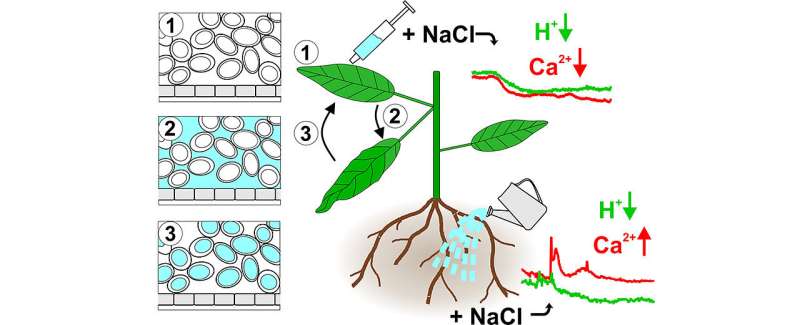Flooding the intercellular spaces with salt causes the leaf to sink temporarily (1 -> 2). After disposal of the salt in the vacuole (3), the leaf resumes its initial position (1). The application of salt causes a decrease in the cytoplasmic calcium ion and proton concentration in the leaf, but an increase in calcium ions in the root. Credit: Kai Konrad / Uni Würzburg
Plant leaves can cope with much higher salt concentrations than roots. The underlying mechanism may help to develop more salt-tolerant crops.
When there is a lack of water, heat or intensive irrigation, the level of common salt (sodium chloride) in the soil increases. However, most crops are sensitive to salt. They react to the increasing soil salinity by greatly reducing their growth. This leads to a reduction in the harvest.
Once absorbed from the soil by the roots and carried with the water flow to the shoots and leaves, the salt can exert its toxic effect on the plant's metabolism. How the plant can escape this dilemma is shown by plant researchers from the Julius-Maximilians-University (JMU) Würzburg in Bavaria, Germany, in their latest publication in the journal New Phytologist.
Biophysicist Professor Rainer Hedrich and his team have developed a methodology that can be used to easily and quickly record how plants detoxify the salt input in their leaves.
Leaf movement as an indicator of salt transport
To investigate the mechanisms for salt detoxification in leaves, Dr. Dorothea Graus as first author of the publication, Professor Irene Marten and Dr. Kai Konrad used tobacco plants as a model system. The intercellular spaces of tobacco leaves can be easily and quickly loaded with test solutions using a syringe.
In order to record the coping with acute salt stress, the inside of the tobacco leaves was flooded with a 30 percent sea salt solution and the reaction was recorded with a video camera. This salt stress triggered a lowering of the pressure in the leaf cells, which became noticeable as the leaf progressively sank.
"We were prepared for this," says Rainer Hedrich. "But the fact that the leaf completely recovered from the salt flooding and returned to its original leaf position after only 30 to 40 minutes was more than astonishing." The injected salt dose remained in the leaf—but not in the intercellular spaces. Instead, it was absorbed into the cell plasma.
The salt, which reduced the pressure in the leaf, was thus imported into the cell and then channeled into the largest cell compartment, the vacuole. Through this step, the water initially lost through osmosis re-enters the cell, whereupon the cell pressure builds up again and the leaf stretches.
How does the salt get into the cell and how does it end up in the vacuole?
Kai Konrad and Irene Marten explain that "sodium ions enter the cell via ion channels and driven by the negative potential of the cell membrane. Chloride ions are taken up by chloride-proton cotransporters, which are fueled by the proton-motive force.
As a result of sodium chloride salt uptake into the cell plasma, the membrane potential temporarily drops while the net proton concentration decreases. These signals, together with sodium ion sensors, initiate salt transport from the cytoplasm into the vacuole. The investigations have shown that the transport at the vacuole membrane strongly co-determines what happens in the cytoplasm and at the cell membrane.
Kai Konrad adds, "Using fluorescence-based detection of proton concentration, we were able to show that the uptake of sodium ions into the vacuole is accompanied by a change in proton concentration in the cytosol and vacuole." This was an indication of the involvement of the NHX1 transporter localized in the vacuole membrane, which exchanges sodium ions for protons from the vacuole during salt stress. "We were able to substantiate this assumption with plant lines whose vacuoles showed increased activity of the sodium ion-proton antiporter NHX1," Kai Konrad explains further.
Groundbreaking exception to the calcium dogma of salt tolerance
In roots, an increase of calcium ions in the cytoplasm triggers sodium ion repulsion forces that reject invading salts into the soil. This salt protection mechanism, also known as the SOS pathway, is also active in the tobacco root. However, the Würzburg research team was surprised to find that the leaves were able to detoxify the administered salt load without any calcium signal at all.
This means that the SOS dogma based on calcium ions is no longer valid with regard to salt stress management in leaves.
"Roots of most plants already suffer when they face a quarter of the salt dose we have imposed on the tobacco leaf," explains Kai Konrad. Leaves thus apparently have better salt stress management and thus salt tolerance than roots. In the case of persistent soil salinization, however, the salt reservoir in the vacuole of cultivated plants runs full and then also brings the salt tolerance in the leaf to its limits.
Understanding the salt toxicity mechanisms in leaves better could help to develop new strategies for producing salt-tolerant crops. To this end, the Würzburg research team aims to use light-controlled ion transport proteins, so-called optogenetic tools, to specifically alter the ion ratios of sodium, chloride, protons and calcium in the cell and thus further decipher the salt transport mechanisms and signaling pathways involved.
More information: Dorothea Graus et al, Tobacco leaf tissue rapidly detoxifies direct salt loads without activation of calcium and SOS signaling, New Phytologist (2022). DOI: 10.1111/nph.18501
Journal information: New Phytologist
Provided by Julius-Maximilians-University (JMU) Würzburg























